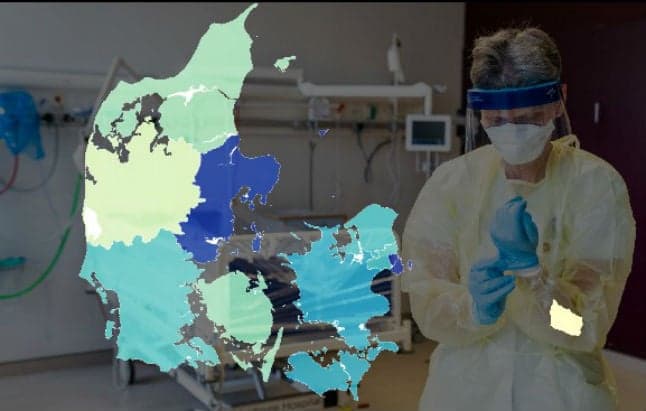map
Paywall free
MAP: The Danish regions most affected by coronavirus

This map shows the regional breakdown of coronavirus cases in Denmark at 8am on Thursday. (Paywall excluded). There are 153 new cases, 1,132 people have tested positive, and six have died.
This map is now no longer being updated, as Denmark has since March 12 only been testing those who are severely ill, or health workers, meaning data for confirmed cases no longer gives a reliable picture of the spread of the infection.
For the latest figures see this map:
The Danish Health Authority (Sundstyrelesen) reported 153 new cases of infection at 8am on Thursday morning, taking the total number known to be infected in Denmark to 1,132. There have been six deaths attributed to the virus.
Here's a map of how the country's various regions are affected (only updated to 8.00am on Thursday):
!function(){"use strict";window.addEventListener("message",function(a){if(void 0!==a.data["datawrapper-height"])for(var e in a.data["datawrapper-height"]){var t=document.getElementById("datawrapper-chart-"+e)||document.querySelector("iframe[src*='"+e+"']");t&&(t.style.height=a.data["datawrapper-height"][e]+"px")}})}();
!function(){"use strict";window.addEventListener("message",function(a){if(void 0!==a.data["datawrapper-height"])for(var e in a.data["datawrapper-height"]){var t=document.getElementById("datawrapper-chart-"+e)||document.querySelector("iframe[src*='"+e+"']");t&&(t.style.height=a.data["datawrapper-height"][e]+"px")}})}();
!function(){"use strict";window.addEventListener("message",function(a){if(void 0!==a.data["datawrapper-height"])for(var e in a.data["datawrapper-height"]){var t=document.getElementById("datawrapper-chart-"+e)||document.querySelector("iframe[src*='"+e+"']");t&&(t.style.height=a.data["datawrapper-height"][e]+"px")}})}();
!function(){"use strict";window.addEventListener("message",function(a){if(void 0!==a.data["datawrapper-height"])for(var e in a.data["datawrapper-height"]){var t=document.getElementById("datawrapper-chart-"+e)||document.querySelector("iframe[src*='"+e+"']");t&&(t.style.height=a.data["datawrapper-height"][e]+"px")}})}();
Comments
See Also
This map is now no longer being updated, as Denmark has since March 12 only been testing those who are severely ill, or health workers, meaning data for confirmed cases no longer gives a reliable picture of the spread of the infection.
For the latest figures see this map:
The Danish Health Authority (Sundstyrelesen) reported 153 new cases of infection at 8am on Thursday morning, taking the total number known to be infected in Denmark to 1,132. There have been six deaths attributed to the virus.
Here's a map of how the country's various regions are affected (only updated to 8.00am on Thursday):
!function(){"use strict";window.addEventListener("message",function(a){if(void 0!==a.data["datawrapper-height"])for(var e in a.data["datawrapper-height"]){var t=document.getElementById("datawrapper-chart-"+e)||document.querySelector("iframe[src*='"+e+"']");t&&(t.style.height=a.data["datawrapper-height"][e]+"px")}})}();
!function(){"use strict";window.addEventListener("message",function(a){if(void 0!==a.data["datawrapper-height"])for(var e in a.data["datawrapper-height"]){var t=document.getElementById("datawrapper-chart-"+e)||document.querySelector("iframe[src*='"+e+"']");t&&(t.style.height=a.data["datawrapper-height"][e]+"px")}})}();
!function(){"use strict";window.addEventListener("message",function(a){if(void 0!==a.data["datawrapper-height"])for(var e in a.data["datawrapper-height"]){var t=document.getElementById("datawrapper-chart-"+e)||document.querySelector("iframe[src*='"+e+"']");t&&(t.style.height=a.data["datawrapper-height"][e]+"px")}})}();
!function(){"use strict";window.addEventListener("message",function(a){if(void 0!==a.data["datawrapper-height"])for(var e in a.data["datawrapper-height"]){var t=document.getElementById("datawrapper-chart-"+e)||document.querySelector("iframe[src*='"+e+"']");t&&(t.style.height=a.data["datawrapper-height"][e]+"px")}})}();
Join the conversation in our comments section below. Share your own views and experience and if you have a question or suggestion for our journalists then email us at [email protected].
Please keep comments civil, constructive and on topic – and make sure to read our terms of use before getting involved.
Please log in here to leave a comment.